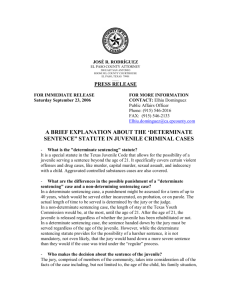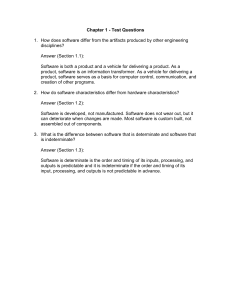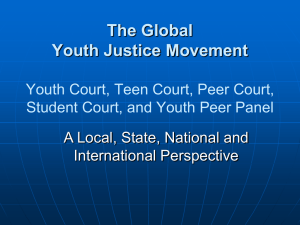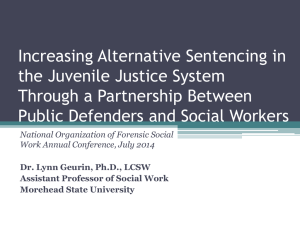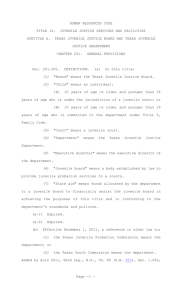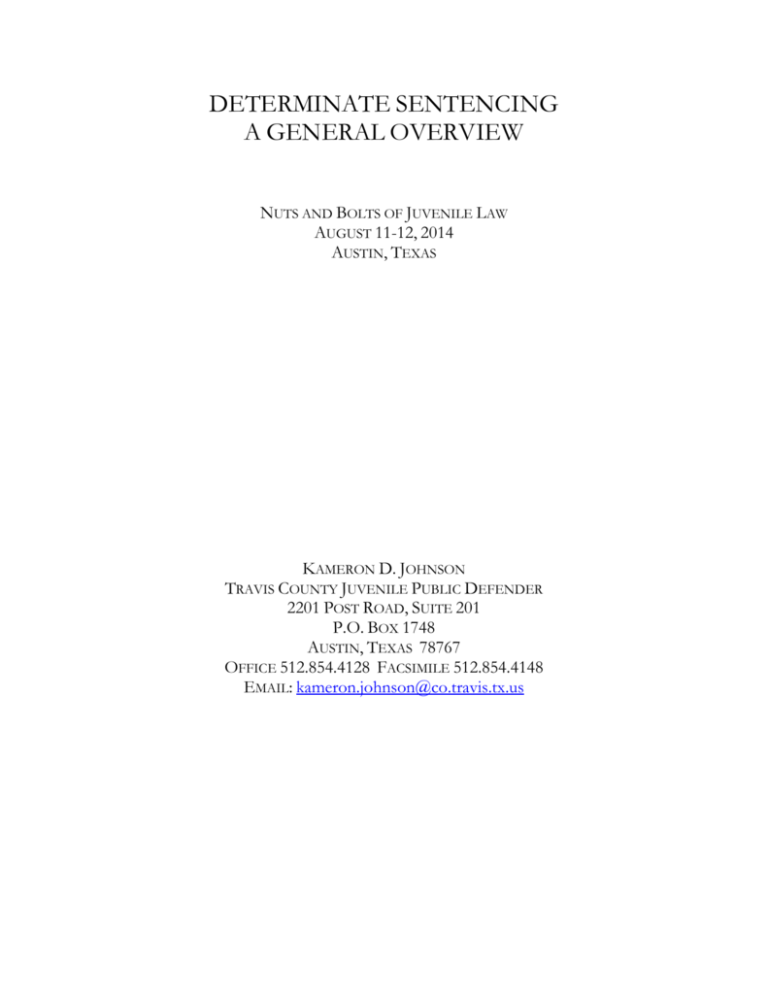
DETERMINATE SENTENCING
A GENERAL OVERVIEW
NUTS AND BOLTS OF JUVENILE LAW
AUGUST 11-12, 2014
AUSTIN, TEXAS
KAMERON D. JOHNSON
TRAVIS COUNTY JUVENILE PUBLIC DEFENDER
2201 POST ROAD, SUITE 201
P.O. BOX 1748
AUSTIN, TEXAS 78767
OFFICE 512.854.4128 FACSIMILE 512.854.4148
EMAIL: kameron.johnson@co.travis.tx.us
TABLE OF CONTENTS
I. Introduction ..................................................................................................................................... 3
II. Determinate Sentence ................................................................................................................... 3
Grand Jury ................................................................................................................................ 4
Adjudication Hearing .............................................................................................................. 5
Disposition Hearing ................................................................................................................ 5
Probation .................................................................................................................................. 5
Parole & Minimum Lengths of Stay ..................................................................................... 6
Transfer Hearings .................................................................................................................... 6
2007 Legislative Changes ....................................................................................................... 6
Summary ................................................................................................................................... 6
Section 53.045 ...................................................................................................................................... 8
2
Determinate Sentencing & Certifications in Texas a General Overview
I.
Introduction
Determinate Sentence
Enacted in 1987 the Texas
Determinate Statue was the first of its
kind in the country.6 Currently, other
states have enacted similar statutes which
are commonly referred to as blended or
mixed sentences.
Under the initial determinate
sentence act a youth would receive a
sentence where the first portion would be
served at the Texas Juvenile Justice
Department (TJJD). Before the juvenile
reached his eighteenth birthday a hearing
would be conducted in the committing
court to ascertain whether the juvenile
would be released on TJJD parole,
discharged from TJJD altogether or
transferred to the Institutional Division of
the Texas Department of Criminal Justice
to serve the remainder of the juvenile’s
sentence.7
Beginning in 1996 widespread
changes to the Determinate Sentence Act
took effect.8 First the range of offenses
eligible for determinate sentencing were
greatly expanded. The list of offenses
currently includes:
Murder
Attempted murder
Capital murder
Attempted capital murder
Manslaughter
Intoxication manslaughter
Aggravated kidnapping
Attempted aggravated kidnapping
Aggravated sexual assault
Sexual assault
Determinate sentencing is a hybrid
dispositional option whereby juveniles
who have been adjudicated for severe
criminal offenses are given a sentence
which includes a term of confinement in
the Texas Department of Criminal Justice
but begins in the juvenile system.1
Determinate sentencing arose in Texas as
a result of the perception of increasing
serious violent criminal acts being
committed by juveniles.2 Prior to the
enactment of the Determinate Sentence
Act of 1987 juveniles under the age of
fifteen could not be certified to stand trial
as adults nor receive a commitment to the
Texas Juvenile Justice Department beyond
the age of twenty-one.3
Numerous
legislative options were proposed to
address this issue with most centering on
reducing the age a juvenile was eligible for
transfer to the adult system.4 As initially
promulgated in 1987 the determinate
sentence legislation covered the six most
serious felony offenses: Capital Murder,
Murder,
Aggravated
Kidnapping,
Aggravated Sexual Assault, Deadly Assault
on a law enforcement officer, Criminal
Attempt to Commit Capital Murder.5
See, Robert O. Dawson, TEXAS JUVENILE LAW §
21 (8th ed. 2012).; Dawson, Texas Blended
Sentencing: An Empirical Study of the Uses of
Determinate Sentencing 17 State Bar of Texas
Section Report Juvenile Law 5-17 (No. 2, June
2003.
2
Dawson, Texas Blended Sentencing: An
Empirical Study of the Uses of Determinate
Sentencing, 17 State Bar of Texas Section Report
Juvenile Law 5-17 (No. 2, June 2003).
3 Id.
4 See Robert O. Dawson, The Third Justice System:
The New Juvenile—Criminal System of Determinate
Sentencing for the Youthful Violent Offender in Texas, 19
St. Mary’s L.J. 943-1016 (1988).
5 Robert O. Dawson, TEXAS JUVENILE LAW § 21
1
(6th ed. 2004).
6 Id.
7
TEX. FAM. CODE §54.11 (before 1995
amendment).
8
Dawson, Texas Blended Sentencing: An
Empirical Study of the Uses of Determinate
Sentencing, 17 State Bar of Texas Section Report
Juvenile Law 5-17 (No. 2, June 2003).
3
grand jury does reject approval the State
can still proceed with the prosecution of
the proceeding either with an Original
Petition without a determinate sentence or
seek certification if appropriate. Approval
of the grand jury is mandatory to invoke
the provisions of the determinate sentence
statute. If the prosecutor does not refer a
petition to a grand jury and obtain
approval then the juvenile court has no
authority to impose a determinate
sentence14. Referral of the
Upon approval section 53.045(d)
states the “fact of approval shall be
certified to the juvenile court and the
certification shall be entered in the record
of the case”15 It is important to note that
as with other rights the juvenile
respondents have the right to grand jury
approval can be waived16.
Attempted sexual assault
Aggravated assault
Aggravated robbery
Attempted aggravated robbery
Felony injury to a child, elderly, or
disabled person
Felony deadly conduct
Aggravated
or
first-degree
controlled substance felony
Criminal solicitation of a capital or
first-degree felony
Second-degree felony indecency
with a child
Criminal solicitation of a minor
First degree felony arson
Habitual felony conduct (three
consecutive felony adjudications)
Criminal Conspiracy.9
Second, the range of punishments
was changed to account for the various
levels of offenses. For third degree
felonies the maximum punishment is ten
years; second degree felonies twenty years
and a maximum of forty years for first
degree felonies and capital offenses.10
Adjudication Hearing
The
requirements
for
an
adjudication hearing for an indeterminate
sentence case and an determinate sentence
case are the same except for a few
differences. In a determinate sentence
case only certain judges can preside over
determinate sentence cases. Juvenile court
referees, associate judges or constitutional
county court judges are prohibited from
hearing these cases.17 Additionally, the
jury composition in determinate sentence
cases must consist of 12 members even
when a county court has jurisdiction.18
Grand Jury
When seeking to proceed under
the Determinate Sentence Act a state
prosecutor has essentially unfettered
discretion.11 However the petition seeking
a determinate sentence must be approved
by the grand jury.12 In considering a case
for approval nine members of the grand
jury must vote approval.13
If nine
members do not vote approval the State
cannot proceed under the act. If the
14
Bleys v. State, 319 S.W.2d 857 (Tex. App.—San
Antonio 2006, no. pet. Robert O. Dawson, TEXAS
JUVENILE LAW § 21 (8th ed. 2012).
15 TEX. FAM. CODE §53.045(d).
16
In re ARA, 898 S.W.2d 14 (Tex. App.—Austin,
1995, no writ)(respondent and attorney have ability
to waive right to grand jury approval ); TEX. FAM.
CODE §51.09.
17 TEX. FAM. CODE §54.10(c); TEX. FAM. CODE
§51.04(c).
18 TEX. FAM. CODE §54.03(c).
TEX. FAM. CODE §53.045(a).
TEX. FAM. CODE §54.04(3)
11 Bleys v. State, 319 S.W.2d 857 (Tex. App.—San
Antonio 2006, no. pet.); In the Matter of S.B.C., 805
S.W.2d 1 (Tex.App.—Tyler 1991, writ denied).
12 TEX. FAM. CODE §53.045(a); §54.04(3).
13 TEX. FAM. CODE §53.045(b).
9
10
4
Disposition Hearings
the court and jury merely granted or
denied probation.
Presently, as in adult cases, once a
respondent is assessed a sentence of ten
years or less and probation is awarded, the
judge makes the determination of the
length of probation.25 If probation is
granted juvenile probation will provide
supervision. Probation will expire at the
juvenile’s eighteenth birthday unless the
prosecuting attorney requests a hearing
prior to the child’s eighteenth birthday
and the court orders probation transferred
to adult probation. Once transferred
adult probation will provide supervision.
In normal delinquency hearings a
juvenile has no right to a jury to determine
disposition.19 In determinate sentence
proceedings juveniles have the right to
have a jury determine sentencing.20 A
requirement for having a jury in the
disposition
hearing
to
determine
sentencing is that the respondent request
or elects in writing before the start of voir
dire his desire for a jury.21
Probation
Juveniles sentenced under a
determinate sentence are eligible for
probation if the sentence received is less
than ten years.22
This provision was
adopted in 1999 with the legislative
amendments to the Act. Before this
provision change probation and juvenile
court jurisdiction of determinate sentence
terminated upon a juvenile respondent
reaching
eighteen
years
old.23
Determinate sentence probation was a
major revision of the Act; the ten year
probation period mirrors probation
options available in adult cases.24 A ten
year probation period gives the juvenile
court and juries a wider sentencing option
and provides for a better handling of case
dispositions. Prior to the changes enacted
regarding probation courts were limited in
granting probation since probation
terminated at the juvenile’s eighteenth
birthday; accordingly, it was more
probable that a term of years was imposed
without probation in those circumstances.
Further juries did not impose any of the
terms or conditions of probation and both
Parole and Minimum Lengths of Stay
The determinate sentence statue
allows TJJD the ability to parole juveniles
without permission from the court once a
minimum length of stay is served. For
Capital Murder the minimum length of
stay is ten years, for first degree felonies
the minimum length of stay is three years;
two years for a second degree and one
year for a third degree felony.26 If a child
is released on parole prior to reaching his
or her nineteenth birthday the TJJD will
supervise him or her until the age of
nineteen at which time supervision will be
transferred to adult parole.27 If the youth
is paroled after the age of nineteen, the
youth is immediately placed on adult
parole to serve the remainder of the
sentence.
Transfer and Hearings
Under current law the Texas
Juvenile Justice Department may request
the committing juvenile court to conduct
a hearing to determine whether to transfer
a juvenile sentenced under the Act to
McKeiver Et. Al. v. Pennsylvania, 403 U.S. 528
(1971); TEX. FAM. CODE §54.04.
20 TEX. FAM. CODE §54.04(a).
21
TEX. FAM. CODE §54.04(a).
22 TEX. FAM. CODE §54.04(q).
23 TEX. FAM. CODE § 54.04(d)(1).
24 Tex. Crim. Proc. Code Art. 42.12 § 3, 4(a).
19
See Tex. Fam. Code § 54.04 (q); compare Tex.
Crim. Proc. Code Art. 42.12 § 4(b).
26 TEX. HUM. RES. CODE §61.081(f).
27 TEX. HUM. RES. CODE §61.084(g).
25
5
prison.28 Section 61.079 states in part:
1. [a]fter
a
child
sentenced to commitment under
Section 54.04(d)(3), 54.04(m), or
54.05(f), Family Code, becomes
sixteen years of age but before the
child becomes 19 years of age, the
commission may refer the child to
the juvenile court that entered the
order of commitment for approval
of the child’s transfer to the
institutional division of the Texas
Department of Criminal Justice if:
a. the child has not
completed the sentence; and
b. the child’s conduct,
regardless of whether the child
was released under supervision
under Section 61.081, indicates
that the welfare of the community
requires the transfer.29
This provision allows TJJD to
request transfer to adult prison those
youth who are not working the programs
or progressing satisfactorily towards
rehabilitation. Once a youth turns sixteen
years old and has been at TJJD for at least
six months transfer can be requested.30
The decision regarding transfer to
prison will be made by the committing
court without a jury.31 In making a
decision regarding transfer the court has
wide discretion;32 the court may consider
various factors such as the child’s history
before and after being committed to
TJJD, the nature of the original offense,
and the recommendation of TJJD.33 When
the purpose of the hearing is to consider
transfer the court may either transfer the
respondent to adult prison or return the
child to TJJD.34
The procedures and guidelines to
be adhered to in a transfer hearing are
addressed in §54.11.
2007 Legislative Changes
During the 2007 80th Texas
Legislative Session major changes were
enacted which dealt with the Texas
Juvenile Justice Department and juvenile
justice. The legislative revisions were the
result of reports of widespread physical
and sexual abuse of children at TJJD
facilities. As a result of the new legislation
a major overhaul resulted in the handling
of juveniles committed to the Texas
Juvenile Justice Department. First, the
age of control was reduced; now the
maximum age of TJJD jurisdiction is 1935.
This reduction will greatly effect
determinate sentencing in that this
reduces the amount of time juveniles can
remain under TJJD control. Secondly, no
longer can juveniles with misdemeanor
adjudications be committed to TJJD. Jury
trials were also affected. Juveniles facing a
determinate sentence must now request a
jury for disposition prior to voir dire or if
not requested timely must have
permission from the State and the Court.36
Summary
Determinate
sentencing
was
enacted in response to an increase in
violent crimes being committed by
juveniles. Although many offenses are
eligible for determinate sentencing few
cases are actually filed as determinate
sentenced.37
A juvenile receiving a
TEX. HUM. RES. CODE §61.079(a)(2).
TEX. HUM. RES. CODE §61.079.
30 TEX. HUM. RES. CODE §61.079(a)(2).
31 TEX. FAM. CODE § 54.11.
32 See, generally, Matter of C.L., Jr., 874 S.W.2d 880
(Tex.App.—Austin 1974); K.L.M. v. State, 881
S.W.2d 80 (1994).
33 TEX. FAM. CODE §54.11(K).
28
29
34 TEX.
35
FAM. CODE §54.11(i).
See generally, TEX. HUM. RES. CODE §§61.079,
61.081, 61.084; TEX. GOV’T CODE §508.156.
36
TEX. FAM. CODE § 54.04(a).
37 For a detailed empirical analysis see, Dawson,
Texas Blended Sentencing: An Empirical Study of
6
determinate sentence has the potential of
serving his or her sentence in a juvenile
prison where rehabilitation and education
are not the primary purpose of the adult
system.
A juvenile who receives a
determinate sentence can never have his
record sealed and even if not transferred
to the Institutional Division of the Texas
Department of Corrections can be under
the supervision of adult parole for up to
forty years.
However, determinate
sentence can be a very beneficial option
when facing the most serious of juvenile
cases—the waiver of jurisdiction and
transfer to adult court.
the Uses of Determinate Sentencing, 17 State Bar
of Texas Section Report Juvenile Law 5-17 (No. 2,
June 2003).
7
§ 53.045 Offenses
Determinate Sentence
Eligible
for
(certain offenses involving controlled
substances);
(a) Except as provided by Subsection
(e), the prosecuting attorney may refer the
petition to the grand jury of the county in
which the court in which the petition is
filed presides if the petition alleges that
the child engaged in delinquent conduct
that constitutes habitual felony conduct as
described by Section 51.031 or that
included the violation of any of the
following provisions:
(11) Section 15.03, Penal Code (criminal
solicitation);
(12) Section 21.11(a)(1), Penal Code
(indecency with a child);
(13) Section 15.031, Penal
(criminal solicitation of a minor);
(14) Section 15.01, Penal Code (criminal
attempt), if the offense attempted was an
offense under Section 19.02, Penal Code
(murder), or Section 19.03, Penal Code
(capital murder), or an offense listed by
Section 3g(a)(1), Article 42.12, Code of
Criminal Procedure;
(1) Section 19.02, Penal Code (murder);
(2) Section 19.03, Penal Code (capital
murder);
(3) Section
(manslaughter);
19.04,
Penal
Code
(4) Section 20.04,
(aggravated kidnapping);
Penal
Code
(15) Section 28.02, Penal Code (arson),
if bodily injury or death is suffered by any
person by reason of the commission of
the conduct;
(5) Section 22.011, Penal Code (sexual
assault) or Section 22.021, Penal Code
(aggravated sexual assault);
(6) Section 22.02,
(aggravated assault);
Penal
Code
(7) Section 29.03,
(aggravated robbery);
Penal
Code
Code
(16) Section 49.08, Penal
(intoxication manslaughter); or
Code
(17) Section 15.02, Penal Code (criminal
conspiracy), if the offense made the
subject of the criminal conspiracy includes
a violation of any of the provisions
referenced in Subdivisions (1) through
(16).
(8) Section 22.04, Penal Code (injury to
a child, elderly individual, or disabled
individual), if the offense is punishable as
a felony, other than a state jail felony;
(b) A grand jury may approve a petition
submitted to it under this section by a
vote of nine members of the grand jury in
the same manner that the grand jury votes
on the presentment of an indictment.
(9) Section 22.05(b), Penal Code (felony
deadly conduct involving discharging a
firearm);
(c) The grand jury has all the powers to
investigate the facts and circumstances
relating to a petition submitted under this
section as it has to investigate other
criminal activity but may not issue an
indictment unless the child is transferred
to a criminal court as provided by Section
(10) Subchapter D, Chapter 481, Health
and Safety Code, if the conduct
constitutes a felony of the first degree or
an aggravated controlled substance felony
8
54.02 of this code.
(d) If the grand jury approves of the
petition, the fact of approval shall be
certified to the juvenile court, and the
certification shall be entered in the record
of the case. For the purpose of the
transfer of a child to the Texas
Department of Criminal Justice as
provided by Section 61.084(c), Human
Resources Code, a juvenile court petition
approved by a grand jury under this
section is an indictment presented by the
grand jury.
(e) The prosecuting attorney may not refer
a petition that alleges the child engaged in
conduct that violated Section 22.011(a)(2),
Penal Code, or Sections 22.021(a)(1)(B)
and (2)(B), Penal Code, unless the child is
more than three years older than the
victim of the conduct.
9

